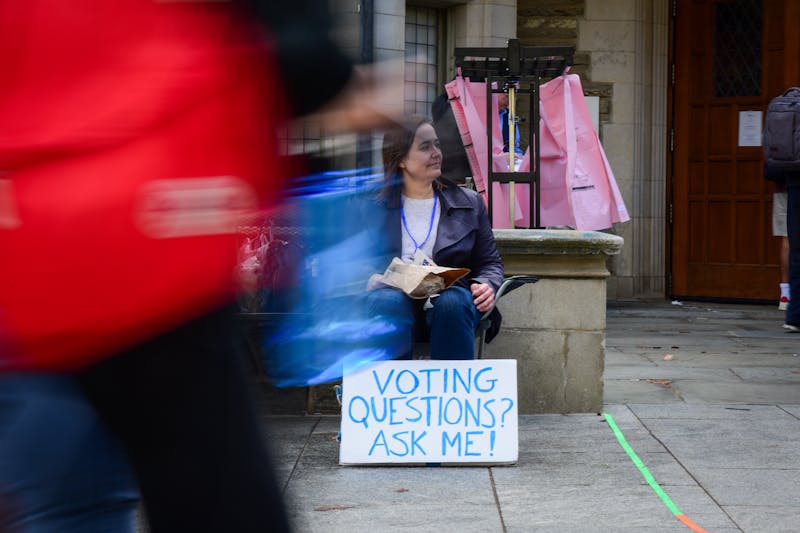"We're working within the Asian group and teaching these kids who although they look Asian, are really white inside. " "I really look back and sort of regret that I was involved with [the Asian-American movement] and ... I felt I was really not in touch with other cultures. I consider myself very American and it's weird how people define it being blue-blooded or WASP-like." "I'd feel a little smaller walking in a room without Asian Americans in it. To adopt, to succeed, to advance, you have to shed your ethnicity. You owe it to yourself to be successful." eing an Asian-American college student means being a part of the most complex and agonizing minority group on campus. The above quotes reveal only an inkling of the massive and exhaustive issues surrounding the concept of what it means to be Asian-American. Unlike the highly volatile African-Americans or the relatively inconspicuous Native Americans, Asian-Americans are endlessly balancing both extremes, oppressed enough to rise and shout yet prosperous enough not to. As a result, the Asian-American identity becomes the source of unending bitterness and uncertainty. For example, the frustration of being stereotyped, the resentment of a professor's ignorance, and isolation felt by having too many Asian friends are all feelings and situations we've encountered as Asian Americans -- and with great difficulty, too. But how we resolve this difficulty, how we justify our action or inaction is the genesis of the great Asian-American Question -- a question that extends far beyond the problem of race to the problem of self. What does it mean to be Asian American? More importantly, what does it mean to be an authentic Asian-American? The Asian-American movement (specifically on college campuses) appears to provide the answers to these questions. By creating specific issues that address the growth and development of Asian Americans, it becomes the source of identity -- a tangible way to assert and solidify one's role in the community. This continually happens at Penn through the formation of political advocacy groups such as SAA (Students for Asian Affairs), the search for a tenure-track Asian-American professor, and the slow materialization of an Asian-American Studies program. As a result, the movement becomes synonymous with self-identification; one's membership in it a reclamation and clarification of one's identity. However, this also means that the people in the movement are given the awesome freedom and power to mold and define an entire generation of Asians and subsequently, map the proper course for future Asian-Americans. By advocating progress for the Asian-American community, the movement grants itself the right to monopolize the identity, touting its constructed definition as inherent fact. It unwittingly constructs a dichotomy composed of those who are "true" Asian-Americans versus those who are assimilated, uneducated, apathetic, white-washed individuals. The movement never questions whether this dichotomy is in fact, a polarization of two distinct sides whose separation is a product of opposition. Instead, it believes that if you call yourself Asian-American, then you must naturally want to support a movement whose only aim is to empower and expand this very identity. If you don't, what does it mean to call yourself Asian-American? What it means to the Asian-American movement is a fear of losing legitimacy, losing electoral power, for activists comprise only a small percentage of the Asian-American population at Penn. The conclusion then, is astonishing for it means that there is a silent, "apathetic" development of an Asian American identity outside of the movement -- that it is in fact, a silent majority. It also means that the backbone of the movement, its very people, want nothing to do with it. Finally, it means the Asian-American movement is failing in its endeavors for unification -- that somewhere buried deep, there's something very wrong. However, rather than face the brutal task of re-examination, the movement finds it easier to dismiss the majority as apathetic, misguided, and misinformed individuals. Rather than confront the problem, the movement suppresses it -- eliminating the existence of pluralism in the process. Contrary to the movement's emphasis on democracy and equality, it enforces and supports a massive hegemony, one in which politicization is inescapable. The result of all this is even more horrific than the cause. After four years of advocating a multi-cultural society, the people in the movement find themselves living, dating, eating only with Asians. They discover that the joint-minority movement really only meant communal space on a flier, an agenda, or on a board. And finally, after countless semesters of protesting, fighting, and recruiting, they realize the relative ease by which they ascended to power came only because college offers no risk. The ethnically diverse community which they hoped to build and maintain becomes less discernible as they step into mainstream society, discovering that success hinges on the subtle shedding of their race and finding that the movement made them even less prepared to face the real world -- a world devoid of privileged minority havens. We need to question the very fundamentals of calling ourselves Asian-American and we need to understand fully the implications of forming a unified identity. We need to deconstruct the movement and find out why, after thirty years, it still cannot convince even half of its people to join. Most of all, if we believe in development and progress, we need to move away from the self-defeating, static definition of Asian-Americanism. Without this revision, redefinition, and perhaps reinvention, the Asian-American Question will never be answered. Betty Liu is a junior English major from Philadelphia. She is the editor of Mosaic, the Asian-American literary magazine.
The Daily Pennsylvanian is an independent, student-run newspaper. Please consider making a donation to support the coverage that shapes the University. Your generosity ensures a future of strong journalism at Penn.
DonatePlease note All comments are eligible for publication in The Daily Pennsylvanian.







